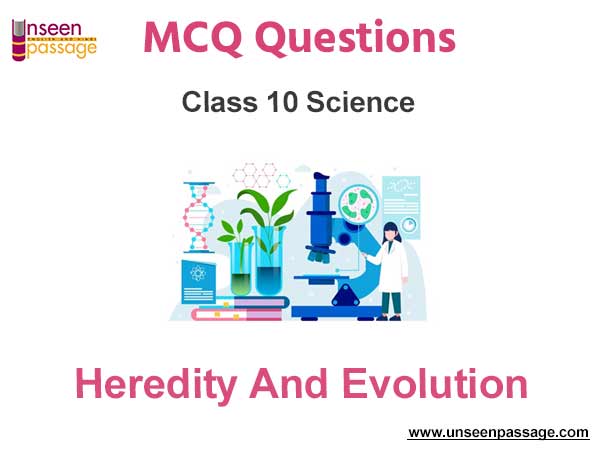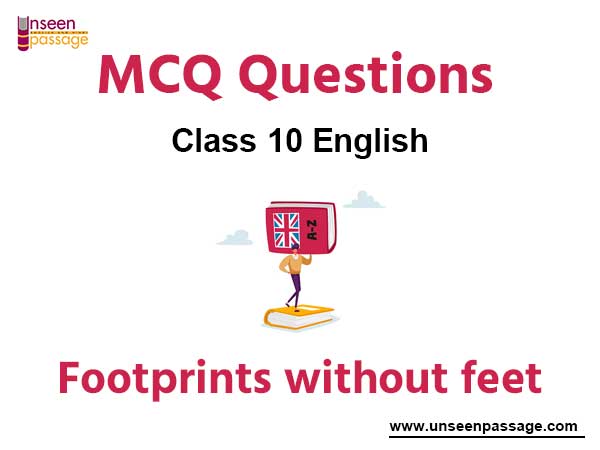Heredity And Evolution MCQ Class 10 Science
Please refer to Chapter 9 Heredity And Evolution MCQ Class 10 Science with answers below. These multiple-choice questions have been prepared based on the latest NCERT book for Class 10 Science. Students should refer to MCQ Questions for Class 10 Science with Answers to score more marks in Grade 10 Science exams. Students should read the chapter Heredity And Evolution and then attempt the following objective questions.
MCQ Questions Class 10 Science Chapter 9 Heredity And Evolution
The Heredity And Evolution MCQ Class 10 Science provided below covers all important topics given in this chapter. These MCQs will help you to properly prepare for exams.
Question. Process of selecting individuals with desired characters by man is called
(a) Hybridization
(b) Reproduction
(c) Artificial selection
(d) Natural selection
Answer
C
Question. Which of the following is not correct-
(a) For every hormone there is a gene.
(b) For every protein there is a gene.
(c) For production of every enzyme there is a gene.
(d) For every molecule of fat there is a gene.
Answer
B
Question. A man with blood group A marries a woman having blood group O. What will be the blood group of the child?
(a) O only
(b) A only
(c) AB
(d) Equal chance of acquiring blood group A or blood group O.
Answer
D
Question. The concept of origin of species by natural selection was given by.
(a) lamarck
(b) weismann
(c) Darwin
(d) Linnaeus
Answer
C
Question. Which of the following is the ancestor of ‘Broccoli’?
(a) Cabbage
(b) Cauliflower
(c) Wild cabbage
(d) Kale
Answer
C
Question. Select the group which shares maximum number of common characters-
(a) two genera of two families
(b) two species of a genus
(c) two genera of a family
(d) two individuals of a species
Answer
D
Question. Human offspring’s sex is determined
(а) through father’s sex chromosomes.
(b) through mother’s sex chromosomes.
(c) by hormones.
(d) by enzymes.
Answer
A
Question. What is the difference between genetic drift and change due to natural selection?
(a) Genetic drift does not require the presence of variation.
(b) Genetic drift never occurs in nature, natural selection does.
(c) Genetic drift does not involve competition between members of a species.
(d) There is no difference.
Answer
C
Question. The human species has genetic roots in
(a) Australia
(b) Africa
(c) America
(d) Indonesia
Answer
B
Question. Assertion: Specialization is the reproductive isolation amongst once interbreeding population.
Reason: Genetic drift, Natural selection and Severe DNA change can cause specialization.
(a) Both A and R are true and R is the correct explanation of A.
(b) Both A and R are true but R is not the correct explanation of A.
(c) A is true but R is false.
(d) A is false but R is true.
(e) Both A and R are false.
Answer
A
Question. The remaps (or impressions) of dead animals or plant? that lived in the remote past are known as
(a) extinct species
(b) fossils
(c) naturally selected species
(d) none of the above
Answer
B
Question. Assertion: Acquired trait cannot be passed on from one generation to next generation.
Reason: Inaccuracy during DNA copying of acquired trait is minimum.
(a) Both A and R are true and R is the correct explanation of A.
(b) Both A and R are true but R is not the correct explanation of A.
(c) A is true but R is false.
(d) A is false but R is true.
(e) Both A and R are false.
Answer
C
Question. Identify the two organisms which are now extinct and are studied from their fossils.
(a) white tiger and sparrow
(b) dinosaur and fish (Knightia)
(c) ammonite and white tiger
(d) trilobite and white tiger
Answer
B
Question. A Mendelian experiment consisted of breeding tall pea plants bearing violet flowers with short pea plants bearing white flowers. The progeny all bore violet flowers but almost half of them were short. This suggests that the genetic make-up of the tall parent can be depicted as
(a) TTWW
(b) TTww
(c) TtWW
(d) TtWw
Answer
C
Question. The genetic constitution of an organism is called.
(a) Genotype
(b) phenotype
(c) variation
(d) gene.
Answer
A
Question. Mendel’s law of segregation is based on separation of allels during
(a) gamete formation
(b) seed formation
(c) pollination
(d) embryonic development
Answer
A
Question. When a red flower homozygous pea plant is crossed with a white flower plant what colour is produced in F1 ?
(a) Red
(b) White
(c) Pink
(d) Red and white
Answer
A
Question. In animals sex determination is due to
(a) X-chromosome
(b) Y – chromosome
(c) A – chromosome
(d) B – chromosome
Answer
B
Question. Back cross is a cross between
(a) F1 × F1
(b) F1 × Recessive
(c) F1 × Dominant
(d) F1 × any parent
Answer
D
Question. The main aim of plant breeding is
(a) to produce improved varieties
(b) to make soil fertile
(c) to control pollution
(d) to become more progressive
Answer
A
Question. Plants having similar genotypes produced by plant breeding are called
(a) clone
(b) haploid
(c) autopolyploid
(d) genome
Answer
A
Question. Two allelic genes are located on
(a) the same chromosome
(b) two homologous chromosomes
(c) two non-homologus chromosomes
(d) any two chromosomes
Answer
B
Question. Origin of life is due to
(a) spontaneous generation
(b) God’s will
(c) effect of sun rays on mud
(d) chemical evolution
Answer
D
Question. Disease resistant varieties can be produced by
(a) crossing a plant with wild variety
(b) treating with colchicine
(c) crossing with hormones
(d) treating with low temperature
Answer
A
Question. The term evolution in Biology means that
(a) fossils are old
(b) life began in Sea
(c) living things constantly change
(d) none of the above
Answer
C
Question. Connecting link between Reptiles and Birds is
(a) dimetrodon
(b) dodo
(c) archaeopteryx
(d) sphenodon
Answer
C
Question. A white flowered mirabilis plant rr was crossed with a red coloured RR, if 120 plants are produced in F2 generation. The result would be
(a) 90 uniformly coloured and 30 white
(b) 90 Non – uniformly coloured and 30 white
(c) 60 Non-uniformly coloured and 60 white
(d) All coloured and No white
Answer
B
Question. The factors which represent the contrasting pairs of characters are called
(a) Dominant
(b) Recessive
(c) Determinants
(d) Alleles
Answer
D
Question. According to one of the most accepted theory the earth atmosphere before any life has originated consisted of water vapour, hydrogen, NH3 and
(a) methane
(b) nitrogen
(c) oxygen
(d) carbondioxide
Answer
A
Question. The ratio of phenotype in F2 generation of a dihybrid cross is
(a) 3 : 1
(b) 1 : 2 : 1
(c) 2 : 1
(d) 9 : 3 : 3 : 1
Answer
D
Question. According to the Neo-Darwinian theory which of the following is responsible for the origin of new species?
(a) Mutations
(b) Useful variations
(c) Mutations together with natural selection
(d) Hybridization.
Answer
C
Question. Which one of these is likely to have been absent in free form at the time of origin of life ?
(a) Oxygen
(b) Hydrogen
(c) Ammonia
(d) Methane
Answer
A
Question. Heterozygous tall plants were crossed with dwarf plants, what will be the ratio of dwarf plants in the progeny
(a) 50%
(b) 25%
(c) 75%
(d) 100%
Answer
A
Question. A pure tall plant can be differentiated from a hybrid tall plant
(a) by measuring length of plant
(b) by spraying gibberellins
(c) if all plants are tall after self-pollination
(d) if all plants are dwarf after self-pollination
Answer
C
Question. Allel is the
(a) alternate trait of a gene pair
(b) total number of genes for a trait
(c) total number of chromosomes of haploid set
(d) total number of genes present a chromosome
Answer
A
Question. What does the progeny of a tall plant with round seeds and a short plant with wrinkled seeds look like?
(a) All are tall with round seeds.
(b) All are short with round seeds.
(c) All are tall with wrinkled seeds.
(d) All are short with wrinkled seeds.
Answer
A
Question. According to the evolutionary theory formation of a new species occurs generally due to –
(a) Sudden creation by nature.
(b) accumulation of variations over several generations
(c) clones formed during asexual reproduction
(d) Movement of individuals from one habitat to another.
Answer
B
Question. Which of the following decides the sex of the child?
(a) male gamete, i.e., sperm
(b) female gamete, i.e., ovum
(c) both sperm and ovum
(d) mother
Answer
A
Question. The theory of chemical evolution of life was experimentally demonstrated by-
(a) Oparin
(b) Miller and Urey
(c) Mendel
(d) Darwin
Answer
B
Question. The number of pairs of sex chromosomes in the zygote of a human being is
(a) 2
(b) 3
(c) 1
(d) 4
Answer
C
Question. A zygote which has an X-chromosome inherited from the father will develop into a
(a) girl
(b) boy
(c) either boy or girl
(d) X-chromosome does not influence the sex of a child.
Answer
A
Question. Mendel proposed that every character is controlled by-
(a) one factor
(b) two factors
(c) one chromosome
(d) two chromosomes
Answer
B

We hope you liked the above Heredity And Evolution MCQ Class 10 Science. In case you have any questions please put them in the comments box below and our teachers will provide you a response.


